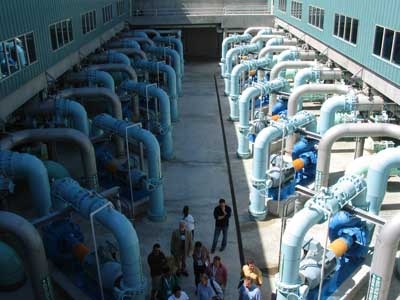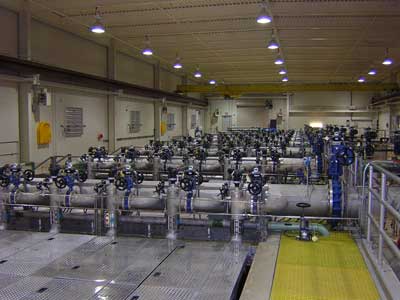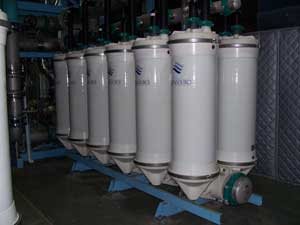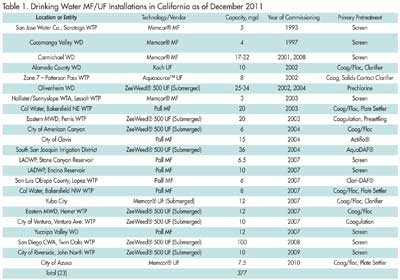California Leads Way in Drinking Water Membrane Filtration
By Joseph M. Wong
The global use of microfiltration (MF) and ultrafiltration (UF) systems for drinking water treatment has drastically increased since the mid-1990s. One reason for the increase is their ability to help meet regulatory requirements for lower filtered water turbidity and for reliably removing pathogens such as Giardia cysts and Cryptosporidium oocysts. Another reason is that continual advances in membrane technologies have led to comparable or lower costs (in certain cases) for membrane filtration vs. conventional filtration systems.
California boasts the first significant MF system (5 mgd, 1993) and one of the largest UF drinking water treatment systems (100 mgd, 2008) in North America. As of the end of 2011, there are more than 20 significant (>1 mgd) California drinking water treatment plants using MF/UF technologies approved by the California Department of Public Health (CDPH).
 |
| Twin Oaks Valley Water Treatment Plant UF System, San Diego County Water Authority. |
Membrane filtration is considered an alternative drinking water filtration technology, and each technology needs to go through proper demonstration procedures to obtain CDPH approval. As of August 2011, CDPH has approved 25 membrane filtration models (from 14 manufacturers) for drinking water treatment in California. An updated list of the approved drinking water membrane technologies, with maximum flux rates and maximum transmembrane pressures, can be found at the CDPH Drinking Water Program website (www.cdph.ca.gov).
History of Membrane Installations in California
The first significant MF system installed for drinking water treatment in California was in the 5-mgd Saratoga Water Treatment Plant owned and operated by the San Jose Water Company. The Memcor® pressure MF system was installed and commissioned in 1993 to replace a diatomaceous earth filter system. It was also the first multiple-mgd MF system in North America. The MF system was installed to deal with wide turbidity variations but with low total organic carbon (TOC) and algae counts, and thus no pretreatment was used except for a screening system to protect the membranes.
The next significant installation was the 4 mgd Arthur H. Bridge MF plant at Cucamonga Valley Water District. Except for some small systems for remote locations (e.g., Placer County Water Agency's 50-gpm MF system) the third significant MF system was not installed and commissioned until 2001 at the Carmichael Water District near Sacramento. The initial capacity of the Carmichael MF system was 17 mgd; the system was later expanded to 22 mgd in 2008. Between 2002 and 2004, nine drinking water MF/UF systems with a total capacity of 152 mgd were installed and commissioned in California. The trend was quiet for three years until 2007 when eight significant MF/UF systems were commissioned.
 |
| Nic de Groot Water Treatment Plant UF System, South San Joaquin Irrigation District. |
The largest UF system in North American (100 mgd) was commissioned in the San Diego area in 2008, followed by two UF systems commissioned in 2009-2010. There was no report of an MF/UF system installed in 2011, but three systems are expected to be installed in 2012-2013 with a total capacity of 76 mgd, and one existing plant will add 4 mgd.
The total installed capacity in California is 377 mgd with 14 pressure and 9 submerged membrane systems. However, the total capacity of the submerged systems is more than twice that of the pressure systems, as the larger systems are of the submerged type (e.g., South San Joaquin Irrigation District, 36 mgd; San Diego County Water Authority, 100 mgd). The largest installed pressure membrane system is the 22-mgd system in Carmichael (expanded from 17 to 22 mgd).
Pretreatment Processes for MF/UF Systems
A variety of pretreatment processes are used in the installed California MF/UF systems. The first three MF systems, as well as six other systems with relatively clean raw water sources, do not have pretreatment except for 500-micron screens used to protect the membranes. Other membrane systems use a variety of pretreatment systems, including prechlorination, coagulation/flocculation, conventional and plate settler clarifiers with coagulation/flocculation, solids contact clarifier, Actiflo®, AquaDAF® and Clari-DAF® with coagulation/flocculation.
The main purpose of pretreatment is to remove a portion of the total organic carbon (TOC) to reduce formation potential of disinfectant byproducts (DBPs) such as trihalomethanes (THMs) and haloacetic acids (HAAs). Algae removal is also an objective for the high-rate AquaDAF® (SSJID) and Clari-DAF® systems (Lopez WTP). The 100-mgd Twin Oaks Water Treatment Plant in San Diego does not have pretreatment for the UF systems; however, TOC removal is accomplished after UF treatment using ozonation with advanced oxidation and biological filtration with granular activated carbon.
 |
| Patterson Pass Water Treatment Plant UF System, Zone 7 Water Agency. |
The use of chemical coagulation/flocculation with or without clarification pretreatment for particle removal is not necessary as demonstrated successfully in the operating systems without pretreatment; however, besides TOC removal, pretreatment helps to reduce the solids loading to MF/UF systems and decrease the organic fouling potential of membranes so that higher flux can be operated and maintained. The increase in flux reduces the number of MF/UF modules required, which may offset a major portion or entire cost of the pretreatment system. This trend seems to continue, as all three membrane plants currently under construction will have coagulation /flocculation /clarification as pretreatment.
Even with standard pretreatment, many of the existing MF/UF systems have experienced membrane fouling and excessive membrane fiber breakage. One UF system experienced serious fouling due to initial startup problems with the solids contact clarifier that caused carryover of iron to the membranes. The problem was not completely solved until the original membrane modules were replaced.
Another utility's UF system never achieved the design flux in operation, although the design flux was previously achieved in the pilot plant. The utility had considered reverting back to conventional filtration to obtain higher capacity.
A couple of UF plants also experienced coagulation problems caused by recycling citric acid from the clean-in-place (CIP) waste to the head of the plant. One plant evaluated several options for acid CIP waste disposal and selected calcium chloride to precipitate a majority of the citric acid from the CIP waste prior to recycling to the front of the plant. Calcium chloride also helped form a stable complex with the remaining citric acid that does not interfere with coagulation when the CIP waste is recycled at controlled rates. Citric acid is a chelating agent that can interfere with the alum/ferric coagulation process. Recent research conducted by University of Central Florida has shown that there is an acetic acid to coagulant molar threshold ratio that could interfere with alum and ferric chloride coagulation.
Spent Backwash Water Management
The CDPH has a Cryptosporidium Action Plan (CAP) that sets guidelines for the recycling of spent backwash water for conventional WTPs. The guidelines include a turbidity of <2 NTU, a maximum flow rate of <10 percent of plant flow, and that the backwash water needs to be recycled to the head of the WTP. Since membrane plants are not considered conventional WTPs the CAP may not be directly applicable.

Most of the membrane plants recycle spent membrane backwash water to the front of the treatment plant where the pretreatment systems include coagulation-flocculation-clarification. In some plants, the spent backwash water is collected and returned to the head of the plants at a controlled rate (<10 percent of influent flow) without pretreatment. In other plants various treatment alternatives are applied and some plants discharge spent backwash water to the sewer for treatment by wastewater treatment plants.
Ceramic Membranes
Ceramic membranes have been introduced to North America for drinking water treatment. There is no full-scale systems but several pilot testing projects have been conducted. Ceramic membranes are more durable than polymeric membranes and can operate at much higher flux at higher pressure, with very high recovery due to infrequent backwash requirements compared to polymeric membranes.
The main drinking water ceramic MF technology in North American is the Kruger Ceramic Membrane (KCM) system supplied by Kruger using elements manufactured by Metawater from Japan. The CDPH has approved KCM for operating at a maximum flux of 175 gallons per sq ft per day (gfd) and a maximum transmembrane pressure (TMP) of 55 psi. KCM pilot testing has been successfully conducted at Bakersfield, Watsonville and San Jose. The City of Watsonville selected KCM over two polymeric membrane technologies for a 2.5-mgd WTP based on a 20-year life-cycle cost comparison and non-cost factors. However, the project has been postponed pending funding availability. A 0.65-mgd KCM system is under design for the Cache Creek Casino in Brooks, California, near Sacramento.
Conclusion
Membrane filtration has gained acceptance by CDPH in place of granular media filtration because of its improved reliability in removing pathogens such as Giardia and Cryptosporidium. MF/UF is seriously considered in most new WTP and expansion projects; however, some of the existing MF/UF plants have experienced operating and maintenance problems, such as excess fiber breakage, fouling and flux limitations.
Despite these drawbacks, the growth trend to use membrane filtration is expected to continue in California as manufacturers continue to improve membrane technologies, and as operating and maintenance personnel gain more experience in working with these advanced systems.
About the Author: Joseph M. Wong, P.E., BCEE, is Chief Engineer and Technology Leader of Advanced Treatment for Brown and Caldwell. He has BS and MS degrees in Chemical Engineering from University of Washington, with more than 30 years of experience in municipal and industrial water/wastewater treatment and reuse. He is primary author of nearly 100 technical papers and articles and four book chapters in the environmental field. He can be reached at jmwong@brwncald.com.
More
WaterWorld Current Issue Articles
More
WaterWorld Archives Issue Articles
Copyright © 2012: PennWell Corporation To subscribe or visit go to: http://www.waterworld.com